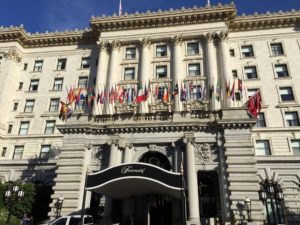
The Fairmont Hotel is the legendary San Francisco landmark that sits atop famed Nob Hill with panoramic views of the city and the bay. This hotel has enough history to fill a book and it has played host to decades of celebrities, politicians, royalty and presidents, along with the less famous. The view from the Crown Room at the Fairmont is spectacular.
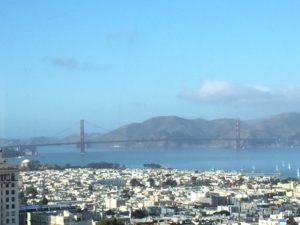
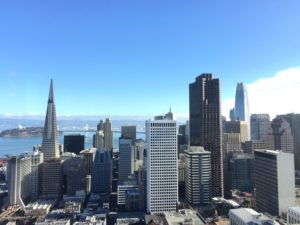
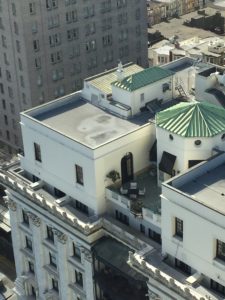
The most famous accommodations at the Fairmont Hotel is the Penthouse Suite that was built by John S. Drum, President of the American Trust Company, as his residence in 1926. The suite has a two story round library, a billiard room, a couple of bedrooms, and a terrace with a fountain. Starting with William Howard Taft, almost every US President, has stayed at the Fairmont Hotel.
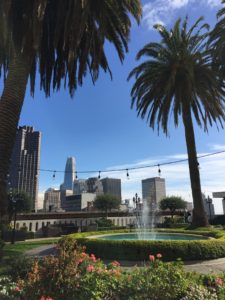
The hotel has lots of interesting amenities such as a rooftop garden with a fountain, outdoor furniture and fire pits. The rooftop garden is open to the public (except when there are special events). The Fairmont Hotel has its own herb garden and they use the honey from their own bee hives on property for your tea, cooking and for making beer. I’ve tried the honey beer and it’s delicious!
The lobby is grand without being overwhelming.
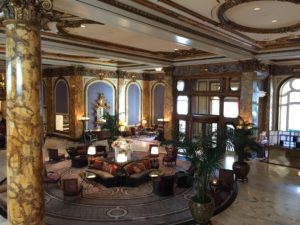
The marble staircase is elegant and provides a wonderful backdrop at Christmas time when children from local schools come and sing Christmas songs in view of their adoring families.
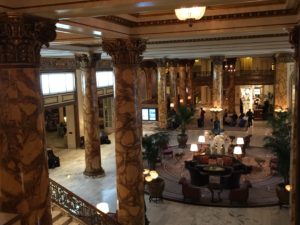
The Fairmont Hotel has many unique features such as the Cirque Room which was the first bar to open in San Francisco after prohibition. The architect, Tim Pflueger, decorated the venue with in Art Deco style with a beautiful bar and gold leaf murals of the Bruton sisters. One of the interesting features of the bar is that the footrest used to have water flowing through it. Guests would toss their cigarettes in the water flowing through the bar’s foot rest. The water would be filtered and cycled back through.
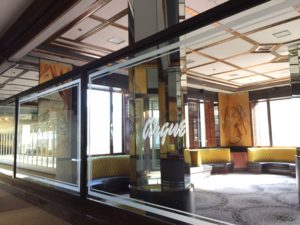
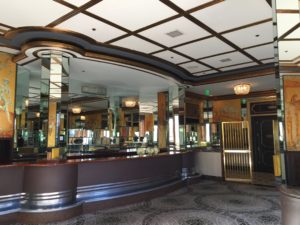
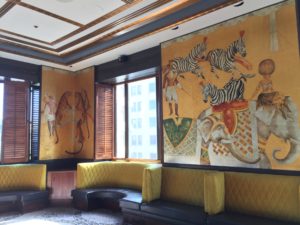
The Fairmont has lots of meeting rooms and some have been preserved from the hotel’s early days. The Vanderbilt Room is one such room. This is the room that Tesse Fair Vanderbilt would have received her private guests prior to going into the adjoining ballroom.
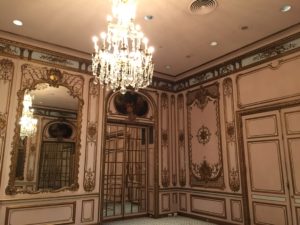
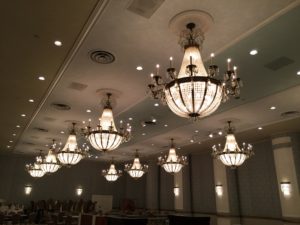
The Gold Room is another ballroom at the Fairmont Hotel that dates back to the original hotel. Notice the ceiling, the chandeliers and the balconies on the side of the room. In days gone by, the musicians were in the balconies playing for the guests below.
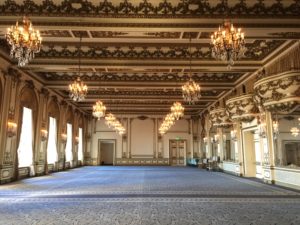
One of the most famous entertainers to perform in the Venetian Room at the Fairmont Hotel is Tony Bennett. He first performed ‘I Left My Heart in San Francisco‘ in the Venetian Room more than half a century ago. The hotel placed a statue of him on the front lawn for his 90th birthday.

The Fairmont Hotel is steeped in history and dates back to before the 1906 earthquake. The land was originally purchased by James Graham Fair aka “Bonanza Jim,” who stuck it rich in the Nevada Silver mines and was one of San Francisco’s wealthiest citizens. He died and his daughters, Tessie and Virginia Fair, decided to build the hotel on the inherited land and name it the Fairmont as a memorial to their family name, Fair, combined with “mont” meaning mountain due to the location on top of Nob Hill. The sisters decided to sell the hotel weeks before its opening to the Law brothers, Herbert and Hartland, in exchange for two existing office buildings at Mission and New Montgomery streets. One of the ladies was planning to get a divorce and this would separate the sisters’ inheritance and allow the distribution of property in the divorce without involving the other sister. The sale included a private agreement where the Law brothers would allow the sisters to buy back the hotel at a later time.
Days after the sale was completed, the San Francisco 1906 earthquake stuck and the fire the followed destroyed much of San Francisco. The Fairmont Hotel structure survived relatively unharmed, but the interior with all of its furnishing burned. The Law brothers felt they had a social responsibility to uphold and made plans to repair and restore the hotel. They hired a New York architect by the name of Sanford White to bring the Fairmont Hotel back to life. Mr. White met his demise at the hands of his mistress’s husband at Madison Square Garden before he could undertake the project. The clock was ticking and the Law brothers proceeded with a bold choice for the succeeding architect. They hired Julia Morgan. Ms. Morgan was a structural engineer and was familiar with and a proponent of reinforced concrete which is a key component in keeping buildings in earthquake prone areas standing. Ms. Morgan was the first woman graduate of the prestigious Ecole des Beaux Arts in Paris. Ms. Morgan applied multiple times to the Ecole des Beaux Arts in Paris and she was rejected every time. It was on her third application, which she signed J. Morgan, that the school accepted her. The school staff was quite surprised when Ms. Morgan arrived since they had not anticipated that J. Morgan was a woman. Ms. Morgan’s renovation of the Fairmont Hotel included replacing the marble interior columns in the hotel lobby with reinforced concrete columns that are significantly larger and stronger than the original marble columns. She left a single original marble column and it can be found today in the shop to the left of the lobby. Julia Morgan went on to become the nation’s preeminent female architect. Her buildings are all over the Bay Area and one of her most famous commissions is Hearst Castle.
Exactly a year after the earthquake, the Fairmont Hotel reopened with a lavish banquet and fireworks. The Fairmont Hotel was a testament to the will of San Francisco to rise out of the ashes and thrive again. The Fairmont Hotel became the social hub of the city and many wealthy families displaced by the earthquake took up long term residence there. As previously agreed, about 2 years after the sale of the Fairmont Hotel to the Law brothers, Tesse Fair Vanderbilt returned and repurchased the hotel. She was the hostess that welcomed Teddy Roosevelt, President Taft, Rudolph Valentino and many others to the Fairmont Hotel. In 1924, D. M Linnard, owner of a chain of hotels in California, purchased Tesse Fair’s interest in the hotel and in 1929 sold it to George Smith, a mining engineer. Smith undertook a major renovation including adding the ‘Fairmont Plunge,’ an indoor pool.
The Fairmont Hotel casts a spell and upon those it touches and in 1941, D. M. Linnard, repurchased the hotel. At this time, its grand days were behind it as the hotel had been neglected due to the depression. Most of the hotel guests were permanent residents and the Fairmont was no longer the jewel on hill.
The end of World War II brought about a rebirth for the Fairmont Hotel. Benjamin Swig, an East Coast businessman, purchased the hotel. Mr. Swig knew the interior of the hotel needed a fresh look and to that end, he commissioned Dorothy Draper, the Coco Chanel of the decorating world, to transform the lobby and public area into romantic showpieces. Ms. Draper’s design innovations included the never before seen back and red carpets and black and gold lacquer reminiscent of the California Gold Rush. The Fairmont Hotel, with Ms. Draper’s efforts, became the place that entranced Royalty, Presidents, and all who stepped through the Fairmont’s doors. The Fairmont Hotel was back on top of the social register as the place to see and be seen.
The United Nations Conference on International Organization, which brought about the birth of the United Nations, used the Fairmont Hotel as the venue for some of its meetings and provided accommodations for some of the delegates. There is a plaque commemorating the drafting of the United Nations Charter at the Fairmont. The flags waving proudly above the hotel entrance are there to commemorate the nations that signed the United Nations Charter. The only flag that was added later is that of the state of Israel. An interesting note regarding the flags: after 9/11, all the flags were replaced with the US stars and stripes for a whole year.
Mr. Swig made other changes to the Fairmont Hotel besides the redecorating executed by Ms Dorothy Draper. Mr. Swig realized that the pool did not provide much revenue and that there was an interest in a South Seas Islands ambiance in San Francisco. He converted the Fairmont Plunge to the ‘S. S. Tonga,’ a place one could enjoy exotic drinks and Chinese food. Mr. Swing went further and transformed the S. S. Tonga into the Tonga Room with a musical boat in the middle of the pool, tiki huts, exotic island drinks and food, and a beautiful dance floor courtesy of the S. S. Forrester, one of the last of the tall ships that traveled between San Francisco and the South Sea Islands. The Tonga Room also has rain and lightning that add to the tropical ambiance.
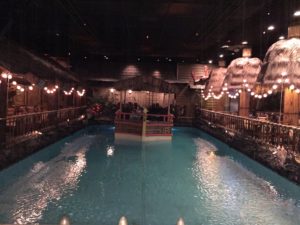
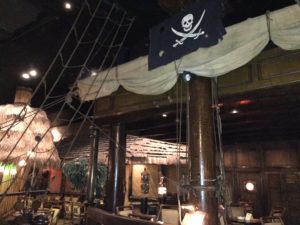
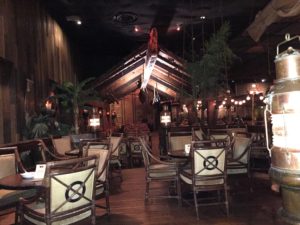
Benjamin Swig’s vision for the Fairmont Hotel included building a 23 story tower which opened in 1961. At the top of the tower is the Crown Room that provides a panoramic 360 degree view of the city by the bay. This space has been a restaurant in the past, and currently is an open ballroom type space.
The Fairmont Hotel has changed hands several times since Mr. Swig. In 1999, the Fairmont Hotel underwent an $85 million restoration to recreate Julia Moran’s vision for the 1907 hotel. The restoration included removing the Dorothy Draper carpeting and showcasing the marble floors beneath it. The Laurel Court has been restored to its original design and serves as the hotel’s main restaurant once more.
The Fairmont Hotel has only one sanctioned tour and this is provided FREE by the San Francisco Public Library. You may sign up for the tour at sfcityguides.org. This organization provides nearly 90 FREE tours.
I’m jealous that I didn’t get to go on this walking tour. I was flying that day!
Make a more new posts please 🙂
___
Sanny